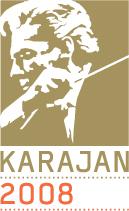Jul 3, 2008 News Herbert von Karajan Edition on audite
Herbert von Karajan would have turned 100 this year. His centennial is being celebrated everywhere in concerts, documentaries, and editions. To mark this occasion audite, too, has decided to release several choice recordings in a Karajan Edition. Vol. I already appeared in May, Vol. II and Vol. III will follow in October.
Karajan’s first recording of the Verdi Requiem (Vol. I) was made during the difficult years in which he was rebuilding his career. It reverberates with echoes of war and the uncertainties of the post-war period. The expressive power and spontaneity of this interpretation reveals a conductor in full command of his audience and musicians alike. This live recording, dating from the 1948 Salzburg Festival, was made with outstanding singers of the time: a very young Hilde Zadek, recently retained for the Vienna State Opera; Margarete Klose, a mezzo-soprano equally favored by Furtwängler; Helge Rosvaenge, the most sought-after tenor of his day; and a magnificent Boris Christoff. The orchestra is the Vienna Philharmonic.
Vol. II (to be released in October 2008) presents Mozart’s Piano Concerto No. 20 (with Wilhelm Kempff) and Symphony No. 41 (The “Jupiter”). This studio recording arose in connection with three concerts held between 21 and 23 June 1956 to celebrate the Mozart bicentennial. It shows Karajan as a Mozart interpreter of great stature and originality. Not only did he unearth a great wealth of orchestral timbres in Mozart’s scores, he also unveiled the structure of the music within these colors. Far removed from rhetoric and virtuosity, Karajan’s Mozart unveils a magic all its own without once becoming sentimental. Even today this Mozart performance, with its stylistic balance between flowing sound and attentive instrumental dialogue, lays claims to more than historical interest.
Vol. III (to be released in October 2008) contains Beethoven’s Third and Ninth Symphonies. These recordings bear witness to Karajan’s early work with the orchestra as a guest conductor and as Wilhelm Furtwängler’s successor, highlighting his quest for depth of sound and breadth of line. Ever since he first encountered the Berlin Philharmonic in spring 1938, Karajan wanted nothing more than to become its principal conductor. But as long as Furtwängler was alive his path to the head of this orchestra was blocked. On 8 September 1953 Karajan made his first guest appearance with the orchestra in eleven years, performing the Eroica and Béla Bartók’s Concerto for Orchestra at the Titania Palace in Berlin-Steglitz. The live recording of Beethoven's Third of this concert is found in Vol. III.
With Furtwängler’s death on 30 November 1954, Karajan’s path became free at last. He prevailed against his competitors and became the new principal conductor of the Berlin Philharmonic. There ensued an arduous period of restructuring the orchestra, its timbral alignment, and its musical philosophy. The live recording of the Ninth, made in the auditorium of the Berlin Musikhochschule on 25 April 1957 to celebrate the orchestra’s 75th anniversary, shows Karajan as its new principal conductor. He succeeded in retaining four singers whose individuality and quality placed them far above any previous recording: Gottlob Frick (bass), Ernst Haefliger (tenor), Marga Höffgen (contralto), and Elisabeth Grümmer (soprano).
All our releases have been included in the official "KARAJAN 2008" Jubilee Portal and awarded its official logo, which serves as a seal of quality for all authorized products of the registered trademark Herbert von Karajanf®. The Karajan logo is granted exclusively by the Eliette and Herbert von Karajan Institute, the executors of Karajan’s artistic and musical estate. It also alerts Karajan fans to special releases and events marking the Karajan Centennial celebrations.
